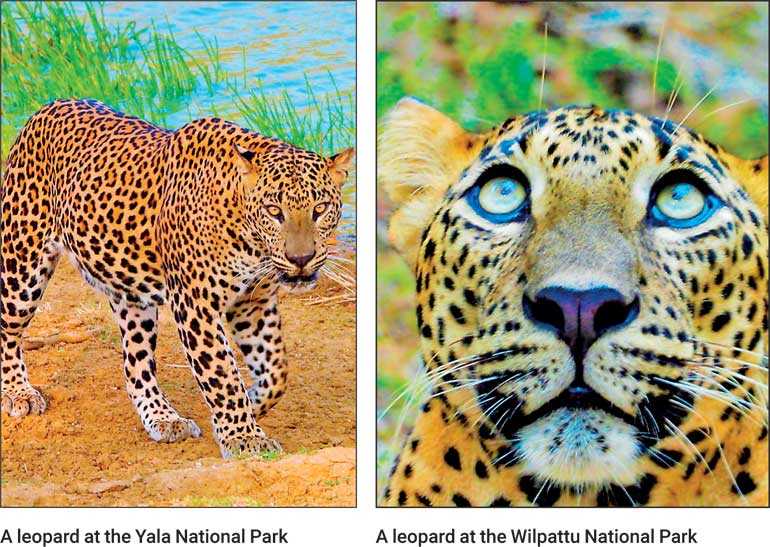Thursday Dec 04, 2025
Thursday Dec 04, 2025
Tuesday, 1 October 2019 00:36 - - {{hitsCtrl.values.hits}}

National animal of Sri Lanka
According to wikipedia.org (2019), Sri Lanka has no official national animal; while locally, the majestic elephant, grizzled giant squirrel and lion are considered to represent the national animal. Ironically, the lion is on the list and the most celebrated animal due to the heraldry factor.
The Sri Lankan lion which is known and celebrated as the Ceylon Lion, unfortunately, is an extinct prehistoric subspecies of the lion (wikipedia.org, 2019). However, Sri Lanka has an official national bird called the Sri Lankan Jungle Fowl—which is a colourful bird and an endemic bird to Sri Lanka.

The importance of a national animal
A national animal is vital in positioning a country, which gives the larger community an overview of what the country’s wildlife tourism holds.
Countries such as India—Royal Bengal Tiger, China—Giant Panda, Kenya—Lion, Australia—Kangaroo are prime success case studies where the country has used the animal to position and market the country’s brand.
Leopard
The leopard is a member of the Felidae, which consist of: cats, cheetahs, lions, tigers, leopards. Found in most of Africa and Asia, the leopard’s adaptability has enabled it to survive in various different geographic areas; including mountains, forests, grasslands and deserts.
However, the leopard is listed as vulnerable on the IUCN Red List, due to leopard populations being threatened by habitat loss.
Why the leopard?
These elusive and secretive creatures are extremely challenging to locate in the wild; and many wildlife enthusiasts globally travel to great ends, to locate this specimen. However, fortunately, it is not the same in Sri Lanka. According to Laurel (2015), as shared on monkeysandmountains.com, Yala in Sri Lanka is ‘Home to the Best Leopard Spotting on the Planet!’
The Yala National Park is claimed to have the highest population density of leopards in the world and incidentally, Yala was known back then as a hunting grounds for the British elites, which is now home to the best sightings of leopards in a park. The sad phenomena is that it is a statement which has not reached the greater audience, let alone the local tourist. If you want to see a leopard, there is no better place than Yala (Laurel, 2015).
The Sri Lankan leopard’s home is not only at Yala. Wilpattu National Park, Udawalawe National Park, Wasgamuwa National Park, Sinharaja Rain Forest Reserve, Minneriya and Kaudulla National Parks, and Horton Plains National Park are few of the many places to spot the elusive Sri Lankan leopard. However, Yala and Wilpattu National Park take the cake for the guaranteed sightings during leopard seasons.
The big question – Can the leopard help Sri Lanka tourism?
The answer is yes.
Sri Lanka cannot continue the same marketing charade of showcasing beautiful landscapes, smiles of Sri Lankan imagery, and new videos promoting Sri Lankan tourism. In the clutter of all promotions, Sri Lanka has not stood out nor will stand out in the future. The traditional approach will not work, times have changed. Sri Lanka needs to adopt to disruptive marketing.
While other countries continue their country branding and promotions, Sri Lanka can grab the world’s attention via officially announcing, that after Sri Lanka’s documented history which spans over 3,000 years, and while still holding on to its lion pride, we can finally introduce, our National Animal as the leopard. 
This will grab the attention not only of the local media, but the foreign media as well. Ground-breaking news is what the media seeks, and what we can deliver. While Sri Lanka makes it to the international media, thereafter it’s supporting the effort with programmatic advertising to reap the maximum benefits and retain the top of mind (TOM) as a destination.
First, we have to grab the attention of the tourist, then give them more than one reason to visit us.

How can we exploit this opportunity?
Simply put, launch the ground-breaking news after 3,000 years, and introduce the leopard via a press conference with local and foreign media. First, the locals need to believe and endorse it.
Following the effort, few of the supplementary touch points would be and is not limited to—launch a stamp, then empathise on Lonely Planet’s Best in Travel 2019, media and digital campaigns, programmatic advertising, invite Nat Geo Wild to make a case study, reach out and get foreign celebrity endorsements, and create more case studies on their visits having an encounter with the leopard.
With this ground-breaking success, apply for awards for results gained and creativity, and results on execution. With all the above efforts, finally, enjoy the success of tourism in Sri Lanka.
(The writer is a Chartered Marketer who is currently heading the global marketing function for over 20 countries, including United States, Australia, Singapore, Malaysia, South Africa, India and Sri Lanka as a Global Marketing Manager for a leading multinational IT company, backed with experience and exposure in management, advertising, sales and marketing.)